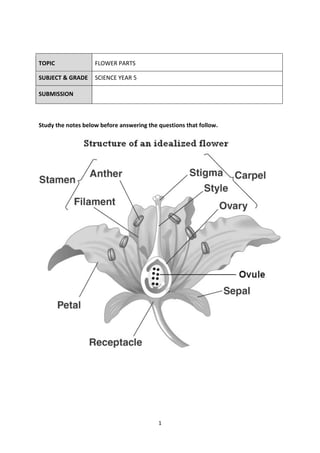Flower parts and its functions
•
13 recomendaciones•32,184 vistas
Notes and Worksheet on Flower Parts and Their Functions. Useful for Cambridge Primary Checkpoint revision tool.
Denunciar
Compartir
Denunciar
Compartir
Descargar para leer sin conexión

Recomendados
Recomendados
Más contenido relacionado
La actualidad más candente
La actualidad más candente (20)
Similar a Flower parts and its functions
Similar a Flower parts and its functions (20)
NEW STANDARDS 6th grade Plants1: classification & processes

NEW STANDARDS 6th grade Plants1: classification & processes
Último
Último (20)
Cyathodium bryophyte: morphology, anatomy, reproduction etc.

Cyathodium bryophyte: morphology, anatomy, reproduction etc.
Asymmetry in the atmosphere of the ultra-hot Jupiter WASP-76 b

Asymmetry in the atmosphere of the ultra-hot Jupiter WASP-76 b
The Mariana Trench remarkable geological features on Earth.pptx

The Mariana Trench remarkable geological features on Earth.pptx
Selaginella: features, morphology ,anatomy and reproduction.

Selaginella: features, morphology ,anatomy and reproduction.
Thyroid Physiology_Dr.E. Muralinath_ Associate Professor

Thyroid Physiology_Dr.E. Muralinath_ Associate Professor
GBSN - Biochemistry (Unit 2) Basic concept of organic chemistry 

GBSN - Biochemistry (Unit 2) Basic concept of organic chemistry
Biogenic Sulfur Gases as Biosignatures on Temperate Sub-Neptune Waterworlds

Biogenic Sulfur Gases as Biosignatures on Temperate Sub-Neptune Waterworlds
Module for Grade 9 for Asynchronous/Distance learning

Module for Grade 9 for Asynchronous/Distance learning
Flower parts and its functions
- 1. 1 TOPIC FLOWER PARTS SUBJECT & GRADE SCIENCE YEAR 5 SUBMISSION Study the notes below before answering the questions that follow.
- 2. 2 1. Flower is a reproductive organ of a plant. 2. It is the part that makes the seeds in order to produce new plants. 3. Fertilisation is the process when male gamete and female gamete are combined together in the ovary. 4. Pollination is the process whereby the pollen from the anther of a flower is transferred to the stigma of a flower. 5. There are two types of pollination: a. Self – pollination b. Cross – pollination 6. Pollination agents: a. Insects b. Wind c. Water d. Animal like birds e. Explosive mechanism 7. Seed dispersal is the movement of seeds away from the parent plant, not by themselves, but with the help of the pollination agents.
- 3. 3 Flower part Function Sepal to protect young flower bud Petal colourful scented to produce nectar to attract insects (pollination agent) Ovary contains ovule ovary matures to become fruit
- 4. 4 Flower part Function Ovule carry female gametes after fertilisation, an ovule becomes a seed Stamen the MALE parts of a flower comprises an anther and a filament a filament holds an anther an anther holds the pollen grains to make pollen grains Carpel the FEMALE parts of a flower also known as pistil comprises stigma, style and ovary stigma is the sticky part that catch pollen grains during pollination style is to hold stigma style is to grow pollen tube to the ovary for fertilisation
- 5. 5 Question 1: Label the following: a) Name the structure labelled as: i. A : _____________________________ ii. B : _____________________________ b) Why do you think the petals of a flower have to be colourful and smell nice? _____________________________________________________________________ _____________________________________________________________________ c) What is another name for carpel? _____________________________________________________________________ d) What is fertilisation? _____________________________________________________________________
- 6. 6 e) What is pollination? _____________________________________________________________________ f) If the seeds have to be dispersed by wind, state THREE characteristics of the seeds: i. _____________________________________ ii. _____________________________________ iii. _____________________________________ g) If the seeds have to be dispersed by water, state THREE characteristics of the seeds: i. _____________________________________ ii. _____________________________________ iii. _____________________________________ h) If the seeds have to be dispersed by animal, state THREE characteristics of the seeds: i. _____________________________________ ii. _____________________________________ iii. _____________________________________ i) Name the pollination agent of the following:
- 7. 7